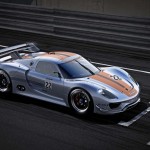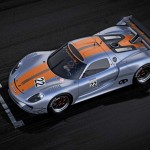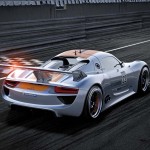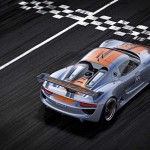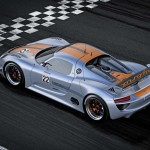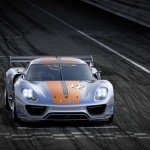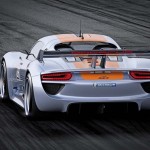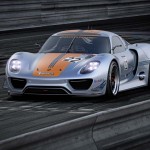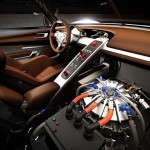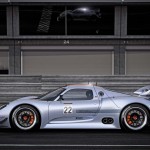Mid-engine 918 RSR is a high-tech test bed for future technology
DETROIT – January 10, 2010 — With the world debut of the spectacular 918 RSR “racing lab,” Porsche AG today highlighted its continued and intensive focus on combining ultimate performance and high efficiency in the field of hybrid technology. The fourth hybrid vehicle presented by Porsche in the last twelve months, the extreme two-seat coupe reveals what happens when the technology fitted to the 911 GT3 R hybrid and the design of the 918 Spyder are fused to a modern, innovative super sports car.
Click here for the full press release describing all the technical details.
Watch a video of the unveiling here: www.youtube.com/watch?v=AW7lstH1TgY
Flywheel technology from the GT3 R Hybrid race car
With its highly-efficient flywheel accumulator, the 911 GT3 R Hybrid racing car was an attention magnet on Germany’s Nürburgring Nordschleife, America’s Road Atlanta and China’s Zhuhai racetracks. It demonstrated its performance potential under racing conditions against very tough competitors, showing competitiveness, high reliability and exemplary fuel efficiency combined with extraordinary performance.
Like that car, the 918 RSR – the motorsports-oriented version of the 918 Spyder – obtains its additional power from its own vehicle dynamics under braking.
The 918 RSR’s mid-mounted V8 engine is a development of the direct-injection engine from the successful RS Spyder race car, and now offers an output of 563 hp at 10,300 rpm. Two electric motors powering the front wheels each contribute 75 kW; leading to a peak power output of 767 hp from the hybrid system.
At the front axle, the two motors offer a torque-vectoring function to increase agility and improve steering response. Ahead of the rear axle, the mid-mounted engine is integrated with a racing transmission based on the RS Spyder. This six-speed constant-mesh transmission with longitudinally-mounted shafts and straight-toothed gears is operated using shift paddles behind the racing steering wheel.
Power generated during braking is stored in an optimized flywheel accumulator, an electric motor whose rotor rotates at up to 36,000 rpm to store energy. Charging occurs when the electric motors on the front axle reverse their function during braking. When the driver needs additional power for acceleration or overtaking, the push of a button calls up the stored energy, deploying it in bursts of up to eight seconds when the system is fully charged.
As in the successful 911 GT3 R Hybrid, the additional power can also be used to reduce fuel consumption by lengthening the amount of time between pit stops.
A hybrid optimized for the racetrack
Racing technology dominates the design of the 918 RSR’s body, where the light, torsionally stiff monocoque is constructed of carbon fibre-reinforced plastic (CFRP). Its functional equipment also underscores the purist, racing character. Doors which open obliquely, a roof-mounted air intake, quick-action locks on the front and rear lids, aerials for pit radio and telemetry, small front wings, splitters beneath the front lip and 19-inch slicks on centre-locking wheels ensure it can be clearly recognized as an experimental racing laboratory.
An unadorned racing atmosphere predominates in the interior of the 918 RSR. A single, figure-hugging bucket seat faces a racing steering wheel and a recuperation display on the steering column, in front of a large display screen to supply the driver with information. Instead of the avant-garde touchscreen centre console of the 918 Spyder, the 918 RSR’s cockpit is split by a minimalist console with rocker switches. Instead of a second seat, the flywheel accumulator is positioned to the right of the console.
Designed to build on a history of intelligent performance
The design of the 918 RSR builds on a tradition established by classic Porsche long-distance race cars such as the 908 long-tail coupé (1969) and the 917 short-tail coupé (1971) and fuses it with a postmodern, form-follows-function philosophy.
In the 918 RSR, the elegant flow of the body is punctuated by muscular wheel arches, dynamic air intakes and a teardrop-shaped cockpit. A visible fan between the ram air intakes – a clear reference to the Le Mans-dominating 917s – and a large rear spoiler emphasize its function as a racing laboratory. The new “liquid metal chrome blue” paint underscores the sculptured curves of the forms, while the brake calipers and the body’s longitudinal stripes are accented with Porsche hybrid orange.
As a final touch, the 918 RSR’s starting number, 22, pays homage to the 40th anniversary of a major triumph. In the days when overall victories in Le Mans were not yet a routine matter within the Porsche racing department, Helmut Marko and Gijs van Lennep won the 1971 edition of the famous 24-hour race. The record set by their short-tail Porsche 917 – 5335.313 km at an average speed of 222.304 km/h – was only eclipsed in 2010. At that time, their 917, painted in Martini Racing colours, was also an experiment ahead of its time, with an ultra-light magnesium space frame that was a milestone for a Porsche race car.
With the new 918 RSR, Porsche elevates its racing hybrid concept to the next, experimental level, where research into the sustainable improvement of efficiency are tested in extreme conditions on the racetrack – a place where, for 60 years, Porsche has consistently demonstrated its success in lap times, pit stops and overall reliability.

